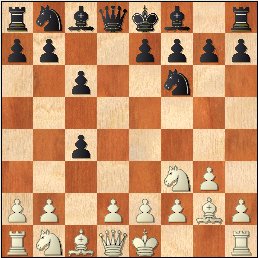Lilleoren,Morten (2386) - Valderas Viejo,Jose J (2281) [A11]
Norway - Spain, 01.10.2003
1.c4 Nf6 2.g3 c6 3.Nf3 d5
4.Bg2!?
Looking back, I could of course claim that
it was all a part of the masterplan to play a
gambit here, but the fact was that I once more just sent
away a move in the opening
without even looking if there were consequences I hadn't
thought about. I can be a
little sloppy with my handling of the move-order issue
4...dxc4!?

There it was. While I was
trying to "regroup", I received the norwegian chess magazine
in the mail.
The main game was Berge Oestenstad's win as black against
Kjetil A Lie in the norwegian championship 2003, ensuring
him (BO) the title. It was this opening.. .. I dived into
the databases, simultaneously letting the silicon-monster go
berserk without interfering. When I surfaced
again some weeks later, I had with me some surprising
concusions in my sack. The first thing
was that the artificial intelligense was convinced that
black was clearly better. The second point
was that my game-material concluded with the opposite. By
luck I had stumbled on to an "ideal variation" for modern
corr.chess players, a variation where the longterm
consequences of a pawn sacrifice is of such a character that
they won't show up if one uses a silicon-product as advicer.
Now then, what's the point of this gambit? First, by taking
the pawn, black weakens his own
barricade in the long diagonal. This gives power to the
bishop at g2. Further on the defence of
the plus pawn will force black to weaken his queenside,
while his pieces will be passive, also defending the pawn
(and the weakened queenside)And at last there is a third,
hidden element
in the position: Because black's behind in development, his king will
remain in the centre for
a long time. This can be fatal if the position opens up.
5.0-0
In his new book about the Reti, Nigel
Davies recommends 5.Qc2 The simplest reason why I didn't
play this, was that the book was still in print when I had
to make my move... :o)
5...Be6
Black continues to surprise. In a base
containing 4 mill. games
I only had 7 predecessors with this position
6.Ng5
of course
6...Bf5 7.Na3 b5 8.Nc2
The knight's task on the brim is ended
after the c4-pawn is guarded. Fortunately the
lost tempi can be regained against the bishop at f5
8...e5?
Enlightened by the course of this game, I
took the same path some months later.
This time black wisely chose to strengthen his queenside by
8...Qb6 but even now he stumbled in his difficulties:
9.Ne3 Bg6 10.a4 Nbd7 11.b3 cxb3 12.Qxb3 h6
13.Nf3 e6 14.d3 a5 15.Nh4 Bh7
16.axb5 Nd5 17.Ba3 Qxb5 18.Qxb5 cxb5 19.Bxf8 Kxf8 20.Nxd5
exd5 21.Bxd5 Ra6
22.Rfb1+- ML-Silkin,A/EM/M/272 2004 (30)]
9.Ne3 Bg6 10.a4
The pawn-phalanx on the queenside
has to be undermined
10...h6 11.Nf3 e4
Black has problems keeping his position
together. This closes the long diagonal
12.Nh4 Bh5 13.axb5 cxb5
14.g4!!
When I first started looking at 12.Nh4, it
was with the intent 14.h3 followed by g4.
That would probably have worked, too, but when I worked my
way into the matter,
I became utterly aware of how weak black's in the long
diagonal. It's only the knight
which keeps it closed. Therefore black can't move it
14...g5?
black goes astray in a position where it's
very difficult to find the right route
14...Nxg4 15.Qc2 Qxh4 16.Qxe4+ Be7 17.Nxg4 Qxg4 18.Qxa8 0-0
19.Rxa7 Qxe2 20.Qd5+/-
And black has a pawn and a lousy white formation as
compensation. It's not enough,
though, because black has a knight that's completely
misplaced on top of the fact that the
pawns on the queenside are very vulnerable. But I still
believe this is black's best;
14...Bxg4? 15.Nxg4 Nxg4 16.Qc2 Nf6 (16...Qxh4 17.Qxe4+
Be7 18.h3 0-0 19.Qxa8 Nf6 20.Qxa7+-)
17.Bxe4 Nd5 18.Bg2 Nc6 19.Qe4+ Nde7 20.Nf5 Rc8 21.Ra6+-
white's attack is irresistable
15.Nhf5
Bg6 16.d3
now there's no doubt
about it - the position will be canned up -
and black's king's still in the centre
16...Nbd7
17.dxe4 Ne5
trying to seal off
whatever's possible
18.Ra6
Nfd7 19.Bd2
White has many
promising continuations here - I thought it was ok to bring
out another piece.
19...Qc8
20.Nd5
At last both the
knights, which on their way both have been at the brim,
are centralized, both at a weak spot in the enemy camp
20...Bc5
21.Nd6+
The last white
knightmove of the game - from move 3 it was made 10
horsejumps altogether, and still white's clearly ahead in
development....
21...Bxd6
22.Rxd6 Qb8 23.Rxd7!
makes the black king
remain in the centre of the events until after the game's
finished.
23...Kxd7
24.Ba5 Rd8
This is actually
black's best move in the position - he has to oppose the
white
pressure in the d-line. If not, the white pieces will pour
in. This is the only way to do that,
a move that simultaneously brings the poor king's rook into
"play". [24...Qd6 25.Bc7+-]
25.Qd2!
the rook doesn't
disappear!
25...Ke8
An attempt to escape
that doesn't come any farther than this
26.Qb4
here there are many
roads to Rome. I choose to shut off the escape
26...Rxd5
There should be a rule
that forbids exchanges of such beauties
27.exd5 Qb7
27...a6 28.d6 Ra7
29.Qc5 Nd7 30.Qd4 f6 31.Qe3+ Kf8 (31...Ne5 32.f4 gxf4
33.Rxf4)
32.Bc7 Rxc7 33.Qe7+ Kg8 34.dxc7 Qxc7 35.Rd1+-
28.f4
gxf4
28...Nxg4 29.f5 Bh5
30.d6 Qb8 (30...Qd7 31.Bxa8) 31.d7+ Kxd7 32.Rd1+ Ke8
33.Bc6#
29.Qd6
Nxg4
29...Qe7 30.Qxe7+ Kxe7
31.d6+; 29...Nd7 30.Qxf4 Rb8 (30...a6 31.d6 Qa7+
32.Kh1+-)
31.Qe3+ Kf8 32.Qxh6+ Ke8 33.Qh8+ Ke7 34.d6+ Ke6 35.Qd4+-
30.Qxf4
Black is actually ahead in
material when he resigns, but after
30.... Qd7 31.h3 this will change
1-0
|